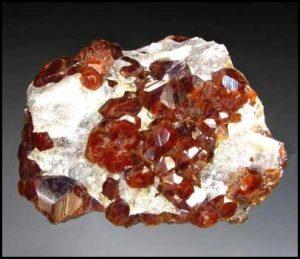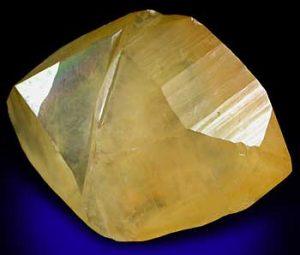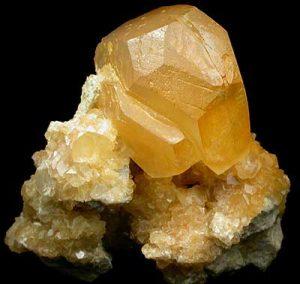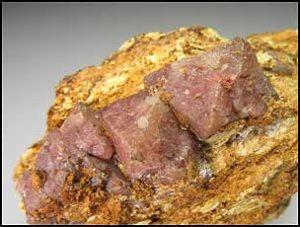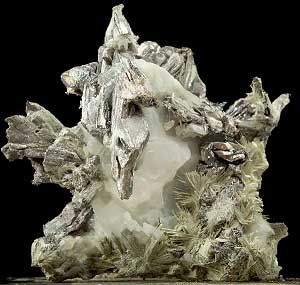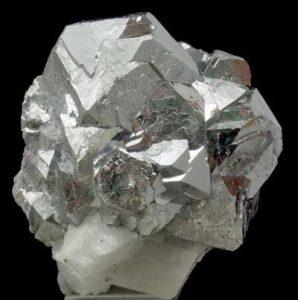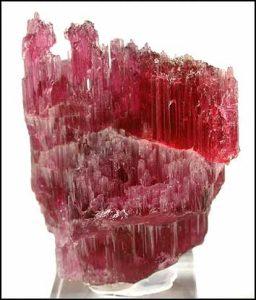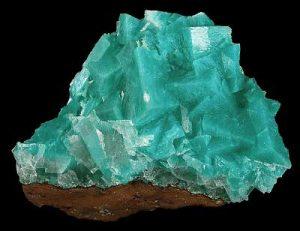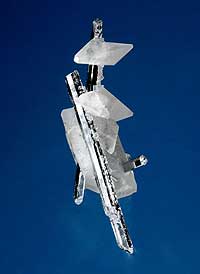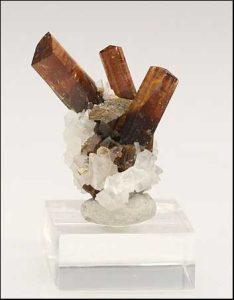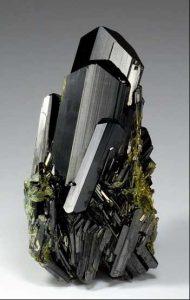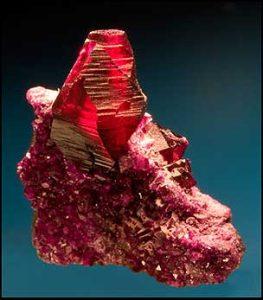Archived Article Detail
By Thomas P. Moore
Need to search for a keyword, title or article on this page? On your keyboard, hold down the “Ctrl” and “F” key and a “Find in page” box will appear at the bottom of your screen. Type in your keyword and check the “Highlight All” box and like magic your keyword will appear highlighted as you scroll up and down the page!
WHAT’S NEW IN THE MINERAL WORLD ARCHIVE – posted on 1/1/2010
With the holiday season over and our holiday-like extravaganza, the Tucson Show, soon to come, here’s a look at a few new things on the web—the better to aid your anticipations of what the new year might bring. While some of the mineral finds described here are echoes from the autumn 2009 show season, still others are indeed likely to be Tucson foreshadowings; one or two “old classic” greats have also resurfaced in modest ways. Happy New Year! On The Web
Andradite in quartz, 6 cm, from the Nightingale district, Pershing County, Nevada. Dakota Matrix specimen and photo. Tom Loomis’s Dakota Matrix dealership (www.dakotamatrix.com) is rare-species-intensive but sometimes shows up with very nice specimens of common minerals, such as the six pretty small-cabinet-size specimens from a new strike of andradite in the Nightingale district, Pershing County, Nevada, which Tom posted in mid-December. Red-brown to orange-red, sharp, highly lustrous dodecahedral garnet crystals, nearly all of them around 1 cm (one exceptional crystal measures 3.5 cm), are half-embedded in massive quartz matrix, one specimen showing also a 3-cm bladed crystal of brownish green clinozoisite. In the Nightingale district, skarns associated with tungsten orebodies have yielded good crystals of garnet, epidote, wollastonite, diopside and clinozoisite intermittently since at least the early 1950s. Commercial tungsten mining ceased in 1956, but the dumps and old mine workings have remained open to collecting since then. In July 2009 a local prospector dug about three flats of the new garnet specimens from what is said to be a “new site” in the Nightingale district, and specimens from the find appeared at the 2009 Springfield Show (see Joe Polityka’s Springfield report in January-February 2010). On that occasion the dealer said that the garnet species in question is grossular, not andradite. But whatever the final species determination may be, these are very good, quite lively-looking items to be added to one’s garnet suite.
Calcite, 6 cm, from the Thomasville quarry, York County, Pennsylvania. John Betts specimen and photo. John H. Betts of New York City (www.johnbetts-fineminerals.com) very often has fine specimens from localities, old and new, on the East Coast. His most recent website update is graced by a handful of very impressive cabinet-size calcite specimens from two long-known but still active localities in southeastern Pennsylvania: the Thomasville (or Lincoln) quarry, in Jackson Township, York County; and the Roosevelt Avenue quarry (also known as the York stone quarry), inside the city limits of York. Both of these limestone quarries harbor cavities lined by sharp, beautiful, golden yellow to orange calcite crystals to several centimeters across, in large clusters, many on white limestone matrix. The Thomasville quarry—where I cracked a boulder or two in my youth—is the site of a single 1992 pocket find of superb, gemmy green sphalerite crystals to 1.5 cm (see September-October 1992, page 437), but except for this one prima-donna occurrence the quarry is known solely for its fat, lustrous, scalenohedral calcite crystals such as the one shown here. Calcite crystals from the Roosevelt Avenue quarry are equant, more face-rich, and tend to be more darkly colored—making for fairly dramatic specimens, of which John Betts now offers several online.
Calcite, 8 cm, from the Roosevelt Avenue quarry, York, Pennsylvania. John Betts specimen and photo.
Marshite, 3 cm, Rubtskoye mine, Altai Mountains, Altayskiy Kray, Russia. Crystal Classics specimen and photo. Superb specimens of cuprite and native copper from the Rubtskoye mine, Altai Mountains, Altayskiy Kray, Russia were first seen in quantity at the 2009 Tucson Show (see my Tucson report, and some vivid accompanying photos of this material, in May-June 2009), and by the time of the 2009 Denver Show the old, re-activated copper mine had also begun to turn out surprising specimens of marshite (CuI) in crystals measuring less than 1 cm but nevertheless excelling the best for the species known previously. Now, Ian Bruce’s Crystal Classics dealership (www.crystalclassics.co.uk) offers nine miniature-size specimens showing sharp, milky white to pink to brown, octahedral crystals of marshite to more than 2 cm, as loose groups and as crystals resting on pale brown gossan-like matrix. To quote Ian’s description, “Marshite is a very rare copper iodide with a distinctive, but not disagreeable, disinfectant-like smell (close up). The crystals start out colorless or yellow, and then turn pinkish to brownish red with sunlight.” We have good reason to hope that this heretofore obscure species will keep emerging in world’s-best-quality specimens from the Rubtskoye mine.
Dyscrasite, 2.4 cm, from the Bouismas mine, Bou Azzer district, Morocco. Spirifer Minerals specimen and photo. Of late I’ve been trying to stay in touch with developments concerning dyscrasite from the Bouismas mine, Bou Azzer district, Morocco—of which you’ll find mention in my 2009 Denver and Munich reports in January-February 2010. Sharp, thin-prismatic, metallic tin-white crystals of the rare silver antimonide (Ag3Sb) are found enclosed in white calcite in the Bouismas mine, and acid treatment to remove the calcite can yield fine specimens showing dendritic formations of dyscrasite to several centimeters across. Well, just after the 2009 Munich Show the Polish mineralogical research and marketing company Spirifer mounted a Moroccan expedition, and at Bou Azzer they acquired a small lot of the best dyscrasite specimens yet found there, with sharp crystals to 2 cm long. Further, some very fine specimens of roselite, with crystals to 1 cm, and of the very rare arsenate species karibibite, have lately emerged from the Bou Azzer district. Best of all (according to Tomasz Prazkier of Spirifer), a November-December 2009 pocket in the Bouismas mine has given up superlative specimens of skutterudite, with brilliant, sharp-edged cuboctahedral crystals to 3 cm in tight groups to more than 10 cm across, enclosed in (but easily freed from) massive white calcite. These are perhaps the best specimens of skutterudite yet taken out of the old cobalt-mining district, and you may shop for some now on the Spirifer site (www.spiriferminerals.com). The Spirifer people are excited also about a promising new fluorite mine near the village of Jorf, from which have come specimens showing transparent cubic fluorite crystals to 5 cm in hues of blue, green, violet and yellow.
Skutterudite, 4.3 cm, from the Bouismas mine, Bou Azzer district, Morocco. Spirifer Minerals specimen and photo.
Rob Lavinsky’s The Arkenstone website (www.irocks.com) now offers 14 thumbnail and miniature-size specimens from the new wulfenite strike at Onderra, Kaokoveld, Kunene region, Namibia. In the 2009 Denver report I noted these pretty wulfenites from Charles Key’s ongoing prospecting work in his favorite African country. Also, Rob has peculiar and lovely miniatures of elbaite from an October 2009 pocket in the famous Cruzeiro mine, Minas Gerais, Brazil. These are loose, lustrous, highly etched clusters of parallel crystals, translucent to transparent and an extremely bright, vivid red; the pocket produced in all just six “cityscape” pieces like that shown here, and Rob acquired four of them at the 2009 Munich Show.
Elbaite, 5.1 cm, from the Cruzeiro mine, Minas Gerais, Brazil. The Arkenstone specimen and photo. It is time now to illustrate one of the beautiful specimens of calcite enclosing aurichalcite that have been trickling out of a site in the Ojuela mine, Durango, Mexico where the Peñoles Company has resumed ore mining, with most satisfactory results for mineral collectors. Rob Lavinsky offered a stash of these specimens at the 2009 Denver Show and now has 36 of them up on his website, in sizes from thumbnail to large-cabinet. His informants say that the latest good calcite/aurichalcite pieces, about 200 of them in all, emerged from a few pockets found in May and July 2009. They show very sharp, simple rhombohedral crystals of calcite, all colored bright baby-blue by aurichalcite, some with a kind of internal brushwork of acicular aurichalcite crystals discernible just under the mirror-smooth calcite faces. On a few specimens, a later generation of calcite, as milky white to colorless and transparent, platy crystals to 1.5 cm, rests on the included blue crystals. Matrix, where present, is the usual rusty brown gossan of the Ojuela mine.
Calcite enclosing aurichalcite, 6.4 cm, from the Ojuela mine, Mapimí, Durango, Mexico. The Arkenstone specimen and photo.
A new website, that of a Wilmington, North Carolina dealership called Geokrazy Minerals (www.geokrazy.com), has about a dozen thumbnails and miniatures from a “new find—11/7/09” of calcite/stibnite in the Wuling (or Wuning) mine, Jiangxi Province, China. In the Mineralogical Record article (March-April 2002) on the Wuling antimony mine, it is made clear that this locality has yielded the world’s finest—anyway, the world’s largest—stibnite specimens, but, the authors write, “calcite occurs [only] in massive form…no significant calcite crystal specimens have been encountered.” That situation has now changed: the Geokrazy specimens show transparent and colorless, lustrous, highly modified rhombohedral calcite crystals to 1.5 cm jumbled together in loose groups with long-prismatic, metallic gray stibnite crystals to 3.5 cm. Recently, similar-looking calcite/stibnite specimens (with the stibnite spears impaling mostly yellow or yellow-orange, tabular crystals of calcite) have appeared on the market, attributed to the Xianghualing antimony mine. The new Geokrazy specimens, with their colorless calcite, appear sufficiently different to argue for the Wuling attribution (I say this hesitantly, as “new” Chinese locality information often partakes more of rumor or misty legend than of hard journalism).
Calcite and Stibnite, 3 cm, from the Wuling mine, Jiangxi Province, China. Geokrazy Minerals specimen and photo. Jeff Fast’s former JBF Minerals has lately morphed to Mineral Movies (www.MineralMovies.com), as Jeff has taken to showing all of his offered specimens rotating on the screen. The rotation speeds are adjustable, freeze-stops are possible, and the effect surely is as seductive as Jeff intends, with strong light impinging dynamically, rhythmically, on faces, edges, and scintillating points of the turning crystal or crystal cluster at hand. The specimens in Jeff’s updates are often one-of-a-kinders, often from Mexico (where he travels) or Connecticut (where he lives), but in mid-December he offered a few intriguing thumbnails and miniatures from a new find of dravite in the great magnesite mine at Brumado, Bahia, Brazil. I’ve seen plenty of earlier dravite specimens from Brumado, but never the likes of these, which show plank-like, partially gemmy, yellow-brown, terminated dravite crystals to 2 cm rising at varied angles from groups of glistening white magnesite rhombohedrons. They are arresting-looking, and of a style wholly new (to me, at least) from this major locality, which was a prolific producer of specimens during the 1970s and early 1990s and now is showing signs of new life.
Dravite on magnesite, 2.5 cm, from Brumado, Bahia, Brazil. Mineral Movies specimen; Jeff Fast photo.
On the (very extensive) site of the German dealership Mineralium.com (www.mineralium.com), a handful of cabinet specimens from an interesting recent find at a venerable Austrian locality are on view. The locality is the old Leckbachrinne emerald mine in the Habachtal, Hohe Tauern, Salzburg. The site has been known as a source of emeralds since Roman times, and has been worked intermittently during most of the centuries since then. The mine has produced emerald crystals to 10 cm, some of a very rich green, in gray-white mica schist matrix, as well as occasional, fairly respectable specimens of phenakite. The mine’s old underground workings are inaccessible now, but collectors still climb up the eastern slope of the Habach Valley to hunt on the dumps, and some of these faithful, sometime in 2008, found the good specimens of actinolite now being offered on the Mineralium.com site. These are parallel and radiating groups of long-prismatic actinolite crystals resting in talc schist matrix; the schist is dull gray-green but the actinolite crystals are lustrous dark green and reach 10 cm in length. Thanks to expert preparation by Andreas Steiner, these specimens, measuring to 27 cm across, are quite nice to look at—amphiboles at their best, and from a classic locality too.
Actinolite, 14.5 cm, from the Leckbachrinne mine, Habachtal, Hohe Tauern, Salzburg, Austria. Mineralium.com specimen and photo.
Speaking of Austrian classics, the brothers Anton and Rudolf Watzl of Watzl Minerals (www.watzlminerals.com) dazzled visitors to the 2009 Munich Show with some top-quality, recently collected specimens of epidote from Knappenwand, Untersulzbachtal, Hohe Tauern, Salzburg: I mentioned these in my Munich report (coming in January-February 2010) but we could not find space for a photo. To compensate, here is an image of a 9.8-cm Knappenwand epidote specimen from the Watzls’ website—clearly a major example of what has come (and still comes!) from the great cleft discovered in 1865. Some of the Watzls’ Knappenwand epidotes are indeed “old” ones, but others have been collected during the past few years, i.e. after cessation of work at the site by the Vienna Museum of Natural History.
Epidote, 9.8 cm, from Knappenwand, Untersulzbachtal, Salzburg, Austria. Watzl Minerals specimen and photo.
A while ago, in this space, I took notice of a new site where connoisseur-quality specimens may be found: Mineral Masterpiece (www.mineralmasterpiece.com), a joint project of seasoned California collector Irv Brown and of young Thomas Spann. Tom is the son of Jim and Gail Spann, already big-league collectors after having been at it for only about five years (Jim and Gail sometimes “seed” the new dealership with donations from their collection)—but Tom, in his own right, holds a degree in gemology and remembers feeling attracted to fine minerals as far back as his childhood in Connecticut. A few months ago, when I first mentioned Irv’s and Tom’s site, it was skimpy, being still in the earliest stages of building, but now it has reached, I’d say, medium size and is jammed with superb photographs (mostly by Tom) of very superb specimens of all kinds and sizes. The site addresses itself to collectors of all income ranges: some excellent miniatures are priced between $100 and $300, and that’s even before we come to the page called “Masterpieces on a Budget.” Just to suggest the fun and aesthetic pleasure that even a hasty drop-in to the site provides, here’s Tom’s photograph of a small-miniature clinochlore variety kämmererite from the Kop Krom mine, Erzerum, Turkey, presented in a December 11 update (and since sold). The kämmererites of the Kop Krom mine, hands-down the best ever found in the world, have not been widely available since the late 1970s; this specimen once belonged to both the Dave Wilber and Jim and Dawn Minette collections.
Clinochlore variety kämmererite, 3.1 cm, from the Kop Krom mine, Erzerum, Turkey. Mineral Masterpieces specimen; Tom Spann photo.
News from Australia If, perchance, your very first association to “Australia” is “crocoite,” then this is the newsflash for you. For the past several years Adam Wright has been digging crocoite specimens in the Adelaide mine, and these specimens, besides being splendid at their best, have been fairly abundant; Adam has brought them in quantity to the past few Tucson shows. But the Adelaide isn’t the only mine in the Dundas-Zeehan, Tasmania mining district which has turned out fine crocoite: there is also the Red Lead (also known as the Dundas Extended) mine, a “major contributor” – wrote Peter Bancroft in Gem & Crystal Treasures—of crocoite by the “thousands of kilograms” during the early 20th century. This past October I got an e-mail from prospector/dealer Shane Dohnt, present leaseholder of the Red Lead (as well as of the nearby Kapi) mine, and this is what he said: New Circulation Manager at the MR The following bulletin will be published (with elaboration) in the January-February 2010 issue, but an advance notice here may be useful until the postperson brings you your copy sometime in January. Effective as of the turn of the year, our Circulation Manager, Mary Lynn Michela, will be retiring after almost 40 years of sterling, devoted service to the magazine. Her duties will be assumed by our new Associate Publisher and Development Officer, Thomas Gressman; hence, any communications, requests, complaints, compliments, inquiries about subscriptions or book or back-issue sales, etc., should now be directed to Tom. His e-mail address is tgressman@comcast.com, or you may call him at 520-529-7281 or (cell phone) 303-246-3194. His mailing address is 5343 N. Sabino Canyon Rd. #17, Tucson, AZ 85750. |
| For questions about this column, please email Tom Moore. |

